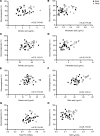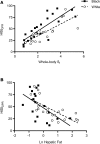Gluconeogenesis and risk for fasting hyperglycemia in Black and White women
- PMID: 30232289
- PMCID: PMC6237227
- DOI: 10.1172/jci.insight.121495
Gluconeogenesis and risk for fasting hyperglycemia in Black and White women
Abstract
Black women, compared with White women, have high rates of whole-body insulin resistance but a lower prevalence of fasting hyperglycemia and hepatic steatosis. This dissociation of whole-body insulin resistance from fasting hyperglycemia may be explained by racial differences in gluconeogenesis, hepatic fat, or tissue-specific insulin sensitivity. Two groups of premenopausal federally employed women, without diabetes were studied. Using stable isotope tracers, [2H2O] and [6,62-H2]glucose, basal glucose production was partitioned into its components (gluconeogenesis and glycogenolysis) and basal whole-body lipolysis ([2H5]glycerol) was measured. Indices of insulin sensitivity, whole-body (SI), hepatic (HISIGPR), and adipose tissue, were calculated. Hepatic fat was measured by proton magnetic resonance spectroscopy. Black women had less hepatic fat and lower fractional and absolute gluconeogenesis. Whole-body SI, HISIGPR, and adipose tissue sensitivity were similar by race, but at any given level of whole-body SI, Black women had higher HISIGPR. Therefore, fasting hyperglycemia may be a less common early pathological feature of prediabetes in Black women compared with White women, because gluconeogenesis remains lower despite similar whole-body SI.
Keywords: Gluconeogenesis; Glucose metabolism; Insulin; Metabolism.
Conflict of interest statement
Figures




Similar articles
-
Pathogenesis of prediabetes: role of the liver in isolated fasting hyperglycemia and combined fasting and postprandial hyperglycemia.J Clin Endocrinol Metab. 2013 Mar;98(3):E409-17. doi: 10.1210/jc.2012-3056. Epub 2013 Jan 23. J Clin Endocrinol Metab. 2013. PMID: 23345093 Free PMC article.
-
Triglyceride Paradox Is Related to Lipoprotein Size, Visceral Adiposity and Stearoyl-CoA Desaturase Activity in Black Versus White Women.Circ Res. 2020 Jan 3;126(1):94-108. doi: 10.1161/CIRCRESAHA.119.315701. Epub 2019 Oct 18. Circ Res. 2020. PMID: 31623522 Free PMC article.
-
Metabolic effects of visceral fat accumulation in type 2 diabetes.J Clin Endocrinol Metab. 2002 Nov;87(11):5098-103. doi: 10.1210/jc.2002-020696. J Clin Endocrinol Metab. 2002. PMID: 12414878
-
Splanchnic regulation of glucose production.Annu Rev Nutr. 2007;27:329-45. doi: 10.1146/annurev.nutr.27.061406.093806. Annu Rev Nutr. 2007. PMID: 17465853 Review.
-
Molecular pathophysiology of hepatic glucose production.Mol Aspects Med. 2015 Dec;46:21-33. doi: 10.1016/j.mam.2015.09.003. Epub 2015 Nov 5. Mol Aspects Med. 2015. PMID: 26549348 Free PMC article. Review.
Cited by
-
Body Fat Distribution, Glucose Metabolism, and Diabetes Status Among Older Adults: The Multiethnic Cohort Adiposity Phenotype Study.J Epidemiol. 2022 Jul 5;32(7):314-322. doi: 10.2188/jea.JE20200538. Epub 2021 Jul 17. J Epidemiol. 2022. PMID: 33642515 Free PMC article.
-
Paving the way for improved action: how nuclear techniques can advance the assessment of malnutrition.Am J Clin Nutr. 2025 Aug;122(2):646-655. doi: 10.1016/j.ajcnut.2025.06.003. Epub 2025 Jun 6. Am J Clin Nutr. 2025. PMID: 40484232
-
Phthalates and Incident Diabetes in Midlife Women: The Study of Women's Health Across the Nation (SWAN).J Clin Endocrinol Metab. 2023 Jul 14;108(8):1947-1957. doi: 10.1210/clinem/dgad033. J Clin Endocrinol Metab. 2023. PMID: 36752637 Free PMC article.
-
Scutellariae Radix and Coptidis Rhizoma Improve Glucose and Lipid Metabolism in T2DM Rats via Regulation of the Metabolic Profiling and MAPK/PI3K/Akt Signaling Pathway.Int J Mol Sci. 2018 Nov 18;19(11):3634. doi: 10.3390/ijms19113634. Int J Mol Sci. 2018. PMID: 30453687 Free PMC article.
-
Prediabetes.Nat Rev Dis Primers. 2025 Jul 17;11(1):49. doi: 10.1038/s41572-025-00635-0. Nat Rev Dis Primers. 2025. PMID: 40676018 Review.
References
-
- Benjamin EJ, et al. Heart Disease and Stroke Statistics-2018 Update: A Report From the American Heart Association. Circulation. 2018;137(12):e67–e492. - PubMed
-
- Utumatwishima JN, Chung ST, Bentley AR, Udahogora M, Sumner AE. Reversing the tide - diagnosis and prevention of T2DM in populations of African descent. Nat Rev Endocrinol. 2018;14(1):45–56. - PubMed
Publication types
MeSH terms
Substances
LinkOut - more resources
Full Text Sources
Other Literature Sources
Medical

